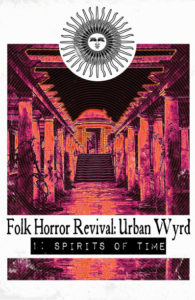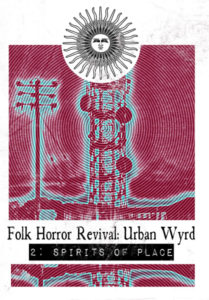Book Review: Folk Horror Revival: Urban Wyrd 1 & 2
I am an unashamed urbanite. For many years now, I’ve been fascinated with the magical dimensions of urban life, with the encounters with the uncanny and strangeness that spring forth, unbidden, during a stroll to the corner shop, in a night walk through the wood. The way a city reveals its multiple hearts through flocks of starlings or in faded graffiti. So when offered the opportunity to review Wyrd Harvest Press’ recent publications, Folk Horror Revival: Urban Wyrd 1 & 2 I jumped at the chance.
What is ‘Urban Wyrd’ though? Just as Folk Horror as a modality for exploring the intersections of the wyrd is, to some degree, bound up with notions of the rural, so ‘Urban Wyrd’ explores the weirdness of the urban environment. As Adam Scovell (author of Folk Horror: Hours Dreadful and Things Strange) points out in his essay in to Urban Wyrd no.1 “It is the strangeness of the everyday”.
Folk Horror Revival: Urban Wyrd 1.Spirits of Time
 Folk Horror Revival: Urban Wyrd 1.Spirits of Time is a 480-page black & white paperback consisting of over 40 different contributions devoted to the many possibilities invoked by this slippery concept of ‘Urban Wyrd’. Here are interviews, examinations of film and television shows, material objects (i.e. ouija boards), accounts of hauntings, wyrd photography, the use of technology (orgone accumulators, electronic voice phenomena), musical explorations and monsters – from the things lurking in the tube to Gorgo. There’s way too much for me to cover it all in the depth it deserves, so instead, I’ll pick out those contributions which caught my attention the most.
Folk Horror Revival: Urban Wyrd 1.Spirits of Time is a 480-page black & white paperback consisting of over 40 different contributions devoted to the many possibilities invoked by this slippery concept of ‘Urban Wyrd’. Here are interviews, examinations of film and television shows, material objects (i.e. ouija boards), accounts of hauntings, wyrd photography, the use of technology (orgone accumulators, electronic voice phenomena), musical explorations and monsters – from the things lurking in the tube to Gorgo. There’s way too much for me to cover it all in the depth it deserves, so instead, I’ll pick out those contributions which caught my attention the most.
First of the highlights for me in this volume is Gray Malkin’s examination of Nigel Kneale’s classic “Quatermass and the Pit”. As a longtime fan of Nigel Kneale’s productions – and the Quatermass series in particular, it’s good to see an analysis of how this film works across multiple registers, unearthing anxieties of alien-ness and a distinctly dystopian spin on the SF trope that aliens have tampered with humanity’s evolution. Another high spot (if that’s the right phrase) is Andy Paciorek’s “Protect and Survive: Dystopian Drama – A Jolly British Apocalypse”. Like Andy, I grew up with this barrage of government media dispassionately informing the British public how it should conduct itself in preparation for a thermonuclear holocaust. Andy examines famous British films such as The War Game – made in 1965 but banned from being shown on television until 1985. I recall seeing it at a special showing in 1980, and just spending the next few days in bed in order to recover. He also looks at Barry Hine’s 1984 Threads – a tale of everyday working-class folk in Sheffield and how they survive (or not) an East-West Thermonuclear exchange of 3000 megatons. What’s truly chilling about Threads is the way it projects a post-nuclear future of blank-eyed children watching fires flickering in broken tv sets. There’s no room here for postnuke heroics as imagined in survivalist fantasies.
Next up is Darren Charles’ “Back to the Countryside: Urban Witchcraft” which does what it says on the lid, as it were – examining the intersections between the figure of the witch and the urban environment in history, in media (such as Morticia in The Adams Family, Vianne Rocher in Chocolate), teen witchcraft – bringing in of course both Buffy and Sabrina and witchcraft, horror and voodoo.
Also deserving of mention is Jim Moon’s look at “Ghostwatch” is an examination of how this classic piece of supernatural drama was brought about, the myths that it spawned, and the aftermath of its showing in 1992. SJ Lyall considers “Silent Invasions” – the perception that all is not right with the world and that those around you are subtly different – alien – in classics such as Invasion of the Body Snatchers, the American tv series The Invaders and the original V – which of itself spawned a whole genre of conspiracy theories.
In amongst all this media analysis Professor Phillip Hull’s “The Eternal Snicket” ( a snicket being, as anyone from Yorkshire, will know, a narrow passageway or shortcut) which treats the snicket as a kind spatial version of the wardrobe that leads to Narnia. Hull seems to have some truly weird experiences with treating shortcuts as opportunities for “not being present in the moment” (but I’m not giving away any spoilers). It’s this kind of willingness to be “deliciously lost” which I think marks the inhabitant of the Urban Wyrd.
Finally, William Redwood’s “Weird Rides: Taxis and Urban Uncertainty” situates the humble taxicab into the cartography of urban wyrd. I’m reminded of the narrator of Lord Dunsany’s “The Beggars” at this juncture: “taxicab (O marvelous, ill-made word, surely the pass-word somewhere of some evil order)”. Drawing in taxi journies (Dracula, Stephen King’s Crouch End to the cabbies themselves (for example, Chas in DC’s Hellblazer and the Efrit in American Gods) showing the apparent disorder and chaos that can lurk behind these seemingly everyday journies.
Folk Horror Revival: Urban Wyrd 2.Spirits of Place
 And so to the second Urban Wyrd: “Spirits of Place”. Fifty-two contributions across 478 pages, focusing on “the strange histories of cities or particular forms of built space”. Once again, here is a cornucopia of essays, interviews ranging from the histories of particular spaces, thoughts on urban music, considerations of psychogeography and hauntology; strange photography, film and televisual explorations, microhistories and much more.
And so to the second Urban Wyrd: “Spirits of Place”. Fifty-two contributions across 478 pages, focusing on “the strange histories of cities or particular forms of built space”. Once again, here is a cornucopia of essays, interviews ranging from the histories of particular spaces, thoughts on urban music, considerations of psychogeography and hauntology; strange photography, film and televisual explorations, microhistories and much more.
The opening essay is Stuart Silver’s “Urban Psychogeography in History, Theory and Practice” which neatly sets the tone for this volume. Silver documents the history of psychogeographical wanderings through urban spaces in its various manifestations – from the Situationists to Landscape Punk; from Baudelaire’s Flâneur to the works of Ian Sinclair and Peter Acroyd. When Silver writes “Let the graffiti, signage, buildings and that odd-shaped stain on the paving stone become your muse.” I find myself reminiscing of my years in Leeds, when that very stance became the bedrock of much of the urban magic I explored in that period.
Karl Bell’s “Through Purged Eyes: Folk Horror and the Affective Landscape of the Urban Weird” explores urban folk horrors – both historical and contemporary – and demonstrates how the denizens of the city are intimately bound up with the experience of urban living. He then goes on to consider the urban environment as an “affective landscape” both unsettling and liberating – a project of urban re-enchantment. Examining spectres as diverse as Spring-Heeled Jack, the ghosts of dead railway workers, and liminal urban spaces such as the Troll Market in del Toro’s Hellboy 2, the buried Martian spaceship in Quatermass and the Pit and the tensions in the work of fantasists such as Machen and Lovecraft, Bell shows how the urban weird can reinvigorate our perception of the urban space.
Another highlight for me is Andy Paciorek’s “Urbex, Haiyko and the Lure of the Abandoned” which explores the lure of derelict and abandoned places. Again, I reminded of a time, when I lived in Yorkshire, of wandering through an abandoned mill – imagining the ghosts of a forgotten industry all around me. Likewise, Howard David Ingham’s “Spontaneous Shrines” which examines the phenomena of tributes left for the dead at the roadside and in woods is something ordinary and every day which deserves more attention. Oz Hardwick and John Pilgrim’s “York: Albion’s Capital of the North” is a short, yet evocative tour through some of the hauntological currents which still flow through the city. I spent three years living in York, and reading this, find long-buried memories stirring. In much a similar vein there is Layla Legard’s “Sorcerer’s Apprentices and Industrial Witches: The Urban Wyrd as Magick in Leeds, West Yorkshire” – although I should ‘fess up, I have a walk-on part in Layla’s examination of the Leeds occult scene of the 1980s having been interviewed by Layla as part of her research. My final highlight pick is Anastasia Lipinskaya’s “The City that was not There: “Absent” Cityscapes in Classic British Ghost Stories” which examines the changing locations of ghosts stories, from gothic castles to country houses, to urban settings – and in particular in key works by Robert Hichens and Herbert Wells.
It’s difficult to sum up Urban Wyrd 1 & 2 as both volumes straddle a huge range of interests. If you’re at all interested in Folk Horror and the weirdness of urban living and its magical potentialities then these volumes are a must-read. Similarly, anyone with an interest in the varied eruptions of occult themes into contemporary visual media – and in particular the dystopian British tv and film of the 1970s will find much food for thought here. Many of the shorter pieces could be used as jumping-off points for further explorations. The editors of both volumes – Richard Hing, Grey Malkin, Stuart Silver & Andy Paciorek – have done a great job of bringing together a wide range of contributors which show the range to which the concept of the ‘Urban Wyrd’ can be applied. If there’s one criticism I would make, it’s that some sense of a contributor’s personal engagement with the urban wyrd is sometimes lacking – perhaps this could be the focus of a future volume?
Both volumes of Urban Wyrd are available direct from Lulu:
Folk Horror Revival: Urban Wyrd 1.Spirits of Time
Folk Horror Revival: 2.Spirits of Place
Other titles from Wyrd Harvest Press/Folk Horror Revival
All sales profits from all books in the Wyrd Harvest Press Lulu online bookstore are charitably donated at intervals to different environmental conservation projects undertaken by The Wildlife Trusts.
